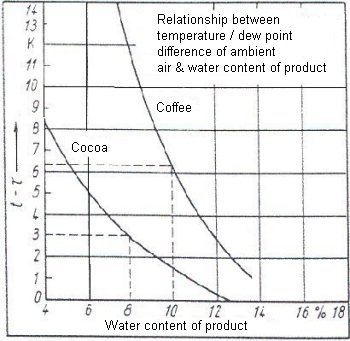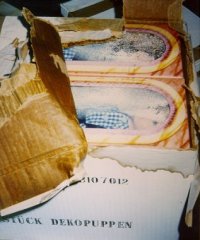Hygroscopic cargoes largely determine the water vapor balance in the container due to their sorption behavior by adjusting the relative humidity of the residual air to the cargo's particular equilibrium moisture content.
The quantities of water which can be released by goods of vegetable origin are still greater. The shrinkage/shortage of goods of vegetable origin arising as a result of evaporation may amount to up to 0.5% of mass depending on the water content of the cargo on loading.
The optimum water content of cocoa beans is between 5 and 6% (see Fig. 16). The higher the actual value is above this, the greater is the tendency of the cargo to release water vapor into the container air.
 |
Figure 16: Sorption isotherms for coffee and cocoa beans showing the limits of "container dry" water content; Svenson [55] |
This water vapor would have to be dissipated, which is impossible in standard containers, being an option which is available only with passively ventilated containers (coffee containers).
The risk of cocoa beans and other goods of vegetable origin absorbing a lot of moisture, on the other hand, is particularly great in the rainy season, making the transport date particularly significant. Goods of vegetable origin are the most intensive source of sweat in a container. These goods are most at risk with regard to hold meteorology. It is impossible to remove such quantities of water from the container by ventilation.
A determining factor for the cryptoclimatic conditions in the container is the type of cargo with which the container is packed, the mass of the cargo and the surface area of the cargo readily accessible to the air also being of significance. Hygroscopic cargoes largely determine the water vapor balance in the container due to their sorption behavior by adjusting the relative humidity of the residual air to the cargo's particular equilibrium moisture content.
By way of example, dolls were gift-wrapped and packed in shipping packages in an excessively moist state. As temperatures fell during the voyage from the Far East to Northern Europe, the relative humidity inside the gift wrapping rose to saturation point, leading to soaking and mold. The result was a total loss, since the mold needed to be removed, and the dolls dried and repackaged (see Fig. 17).
Care must always be taken to ensure that the cargo is packed into the container in a container dry state.
 |
Figure 17: Mold damage on cargo that was not container dry; Photo: Scheen [48] |